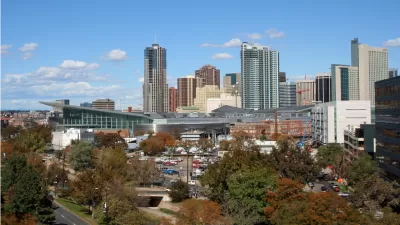Guess which group is losing faith in the American Dream? Washington Post Wonkblog reporters Jim Tankersley and Scott Clement write on a Fusion 2016 Issues Poll released December 1 that surveys millennials on their chances for upward mobility.

"(Y)oung workers today are significantly more pessimistic about the possibility of success in America than their counterparts were in 1986, according to a new Fusion 2016 Issues poll reported in conjunction with The Washington Post," write Jim Tankersley and Scott Clement.
That rise in pessimism among millennials is concentrated among white people. It is most pronounced among whites who did not earn a college degree.
The comparison to 1986 comes "from a Roper/Wall Street Journal poll of young Americans" conducted that year. The Fusion poll replicates it so as to compare attitudes of today's millennials with the same age group 29 years ago. Unlike whites, "(t)he poll found no statistically significant change among young Americans of color over the decades," note Tankersley and Clement.
In 1986, they were about twice as likely as whites to say the American Dream does not exist. Now, the groups are about equally pessimistic.
As has been reported here, "(m)illennials in general define the dream differently than Generation Xers did in the 80s," write the reporters.
Today's young people are less likely to say owning a home or having "freedom of choice in how to live one's life" and the ability to become wealthy are part of the American Dream. They are more likely to say that starting a business was part of the dream; [ ...] that item topped millennials' list of possible American Dream components.
"And one of the big components of the American dream—the pursuit of wealth—is also losing ground among young people," writes Fusion's Katie McDonough. "Becoming wealthy ranked dead last—listed by just 29% of young people as very much part of the American Dream, down from 40% in 1986."
Click on the graphics showing the top three goals of young people in 1986 and today.
FULL STORY: Young white people are losing their faith in the American Dream

Study: Maui’s Plan to Convert Vacation Rentals to Long-Term Housing Could Cause Nearly $1 Billion Economic Loss
The plan would reduce visitor accommodation by 25,% resulting in 1,900 jobs lost.

North Texas Transit Leaders Tout Benefits of TOD for Growing Region
At a summit focused on transit-oriented development, policymakers discussed how North Texas’ expanded light rail system can serve as a tool for economic growth.

Why Should We Subsidize Public Transportation?
Many public transit agencies face financial stress due to rising costs, declining fare revenue, and declining subsidies. Transit advocates must provide a strong business case for increasing public transit funding.

How to Make US Trains Faster
Changes to boarding platforms and a switch to electric trains could improve U.S. passenger rail service without the added cost of high-speed rail.

Columbia’s Revitalized ‘Loop’ Is a Hub for Local Entrepreneurs
A focus on small businesses is helping a commercial corridor in Columbia, Missouri thrive.

Invasive Insect Threatens Minnesota’s Ash Forests
The Emerald Ash Borer is a rapidly spreading invasive pest threatening Minnesota’s ash trees, and homeowners are encouraged to plant diverse replacement species, avoid moving ash firewood, and monitor for signs of infestation.
Urban Design for Planners 1: Software Tools
This six-course series explores essential urban design concepts using open source software and equips planners with the tools they need to participate fully in the urban design process.
Planning for Universal Design
Learn the tools for implementing Universal Design in planning regulations.
City of Santa Clarita
Ascent Environmental
Institute for Housing and Urban Development Studies (IHS)
City of Grandview
Harvard GSD Executive Education
Toledo-Lucas County Plan Commissions
Salt Lake City
NYU Wagner Graduate School of Public Service




























